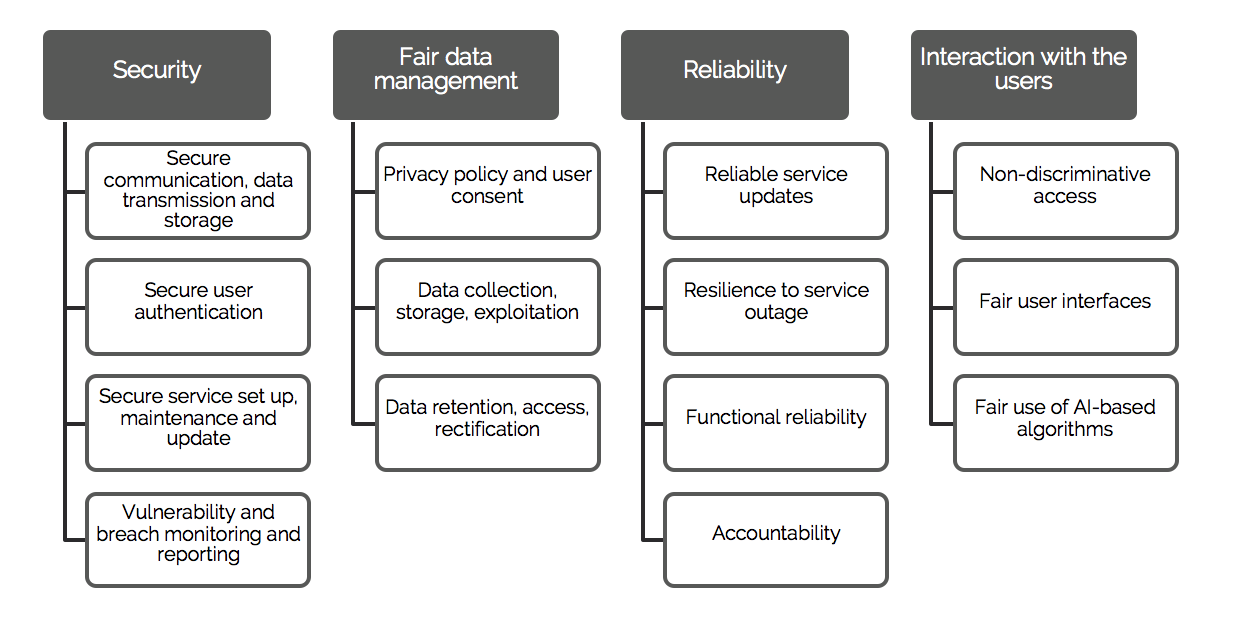Digital Trust Label in a Nutshell
February 2021

This blog post aims to give a short introduction about the Digital Trust Label, what we want to achieve and how it is positioned regarding similar initiatives.
The Label is based on two core principles:
- First, behind its visual display lies a bundle of benchmarked technical and ethical criteria that have been verified and audited by an independent third party.
- Second, its standards and criteria were, and always will be, determined in a co-creation process involving academia, civil society, business and, above all, consumers.
The Label empowers consumers with knowledge about levels of risk, so that they can make confident and informed choices when they interact with service providers. Consumers will know that the display of an DTL trust score means the service provider has earned the right to use it: getting it will be difficult. It safeguards against conflicts of interest, not only by upholding criteria set by independent technical experts, but by providing independent and impartial mechanisms of verification and conflict resolution.
The label communicates five levels of commitment – rated and displayed in a risk-assessment scorecard. It does not provide absolute certainty. Instead, it offers assurances that a number of critical criteria of best practice are being adhered to:
- The service provides a high degree of security and data protection.
- The users’ privacy is respected.
- The service is reliable and that promised outcomes are assured.
- The service is easily understood and fair.
- There’s accountability and conflict resolution because the service provider’s ability to use the Label carries a commitment to independent conflict resolution.
Championing the consumers
The citizen-consumer, as both the object and subject of the digital era, now occupies a position in society that few anticipated. Their changing needs mediated through complex technologies cannot be specified at the outset. As suggested above, a condition of non-perfect knowledge is intrinsic to how trust is realised and sustained today as well as in the future.
This, in essence, explains why the DTL sees itself as the champion of the consumer and why consumer-centricity is the founding principle.
There are three core assumptions which flow from this understanding and thus which informs the DTL’s approach:
- First, digital trust cannot be solved, only managed. This means a multi-year investment with a commitment to independent audit systems that can resolve issues rapidly and fairly. The absence of this will ensure trust will remain an area of risk rather than opportunity.
- Second, there are no technical solutions to the trust deficit. The gaining of trust involves a constant battle of reducing technical complexity in the experience of digital practice. Better informed and aware consumers who have a vocabulary to express their concerns will legitimise and drive the digital future.
- Third, that trust is, essentially, an ongoing practical challenge. This requires engaging consumers in a dialogic partnership, not a top-down monologue with the consumer as the end point of the conversation. Meeting this requirement in practice demands that the digital ecosystem institutionalises a sensitivity to change and a communications feed-back loop for the entire ecosystem.These assumptions underlie the DTL’s commitment to making consumer-centricity concrete. It is an approach that offers the digital ecosystem a sustainable way to approach the problem of trust because it can help transform an area of ongoing uncertainty and risk into a more manageable opportunity.
Positioning with regards to similar initiatives
Several national and international initiatives have chosen to define benchmarks used as the basis for delivering labels, seals and similar certifications. Since the beginning of the project, SDI has mapped all existing and abandoned similar projects (as of February 2021: over 50) to get a better understanding of the diversity of existing types of initiatives and actors, their aim, where their focus lies, and how these initiatives function. Many initiatives are still in their early development while others have been launched, yet failed to gain widespread acceptance and use.
The Digital Trust Label, as SDI aims to implement it, differs from similar projects in the following aspects:
- It takes a holistic approach and defines an ethical sound service through four main categories: Security, Privacy and Data Protection, Service Reliability, Interactions with Users
- It’s defining ethos is consumer-centricity.
- Co-developed by technical experts, civil society, business, governments and, above all, consumers.
- Global in ambition.
- World leading calibrated, bundled technical and ethical criteria.
- Operational control and auditing in the hands of an independent third party.